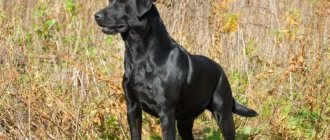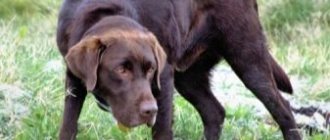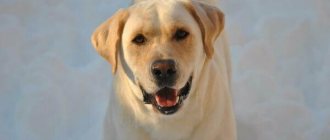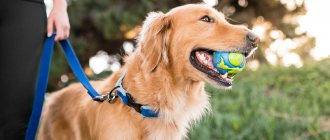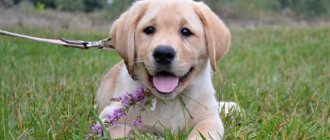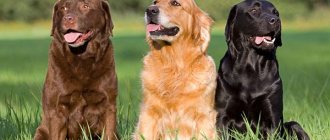Labrador is a classic. In cinema, literature, and painting, these dogs are found quite often, and therefore are very recognizable and discussed. Thus, there is a misconception that the color of a Labrador is related to its character: white dogs are lazy, black dogs are energetic hunters, and a brown puppy will grow up stubborn and cunning. But any breeder will easily refute this. But no one will deny that in this breed the color of the coat never matches the undercoat.
History of the breed
The history of the Labrador Retriever dates back to Britain in the 1830s, where these dogs were first seen on ships trading between the Labrador region of Canada and Poole, a town in Dorset.
In the beginning, Labradors were often confused with the much larger Newfoundlands and the so-called St. John's water dog (literally - St. John's water dog).
The first Labrador was described as a dog no larger than an English pointer, usually black, with a long muzzle, strong limbs, and short and smooth hair.
Labrador photo
The first photograph of a Labrador was taken in 1856, of a dog named Nell, who belonged to one of the breed's original patrons. By 1870, the name Labrador Retriever had already become firmly established in England.
In 1903, the breed was recognized by the English Kennel Club (the largest breed registration organization in the UK), and in 1917 by the American Kennel Club.
This is how the history of Labradors began.
How to choose?
When choosing a puppy, you need to be guided not only by useful tips, but also by common sense, taking into account certain details:
- why and how you will keep a specific dog;
- take into account how active it is;
- assess your capabilities: whether you can devote the right amount of time to her;
- how much space will be allocated for her space.
A large dog needs a lot of space, and you also need to decide whether you are taking the puppy for further breeding or as a friend. Having studied all the nuances of this breed and made a firm decision to buy such a dog for ourselves, we begin the search for a breeder. This can be either a professional club or a private breeder. Then you need to inquire about the availability of puppies; if there are few of them, you need to be extremely careful, since the strongest and most active ones are taken first.
The puppy purchased must be at least 1.5 months old. He must have all his vaccinations
When examining the individual you like, you need to pay attention to some features:
color standard; complete coloration of the mucous membranes of the nose and lips; the baby should be active and friendly; do not show fear or attacks of aggression; must be proportional and move confidently; special attention should be paid to the correct bite.
Useful tips.
- If you are getting a Dudley dog, then you should consider that at times he may not demonstrate the best behavior. The reason for this is that pets of this color often have problems with vision and hearing.
- Labradors of any color are big fans of bath treatments. Bath your pet in a timely manner and play with it in the water.
- All fawn (yellow) Labradors can be disqualified if they do not have characteristic pigmentation of the skin around the eyes, nose and gums that contrasts with the general color, have a different shade of the iris of the eyes, or have spots on the coat (brown or snow-white).
See below for Labrador color variations.
Description of the Labrador Retriever breed
Today, the standards and characteristics of the Labrador Retriever breed are regulated by the FCI organization - the International Canine Organization. A detailed description of the Labrador breed is established in it under a new edition of 2011.
The appearance of the dogs is admirable - they are a large, slender and at the same time muscular breed. Belongs to the category of smooth-haired breeds.
Photo of Labrador Retriever
Head
The Labrador is a dog with a massive skull and a wide forehead. Usually the head is perfectly balanced in all its individual parts. It is not too large, but at the same time not small - medium in size. The transition from the base to the muzzle is clearly pronounced, and the muzzle itself has no pronounced cheeks.
The length of the Labrador's jaws is short, rather medium. The jaws are quite strong.
The nose is quite wide and has prominent nostrils.
These dogs also have medium-sized eyes, usually brown. Although hazel eye color is quite typical for the breed. When you look at them, you immediately get the impression of the dog’s boundless intelligence and good-natured character.
The Labrador is characterized by a medium-length neck, which has an ideal contour, without unnecessary lines.
The ears on the head are set in the back, fitting tightly to the base of the skull. The ears are hanging type, not heavy.
The teeth are located in a vertical position, which is convenient for gripping, and have an ideal bite.
Neck
The Labrador is characterized by a medium-length neck, which has an ideal contour, without unnecessary lines.
Frame
These animals have a fairly powerful chest, proportional to the entire body. The ribs are brought together well and tightly. The exterior is massive with a straight topline.
In proportion to the chest, the lower back is just as massive - it is wide and at first glance one can feel the strength in it.
Front legs
This breed is characterized by rounded, powerful forelimbs. They are absolutely straight from the elbow joint to the bottom. The toes on the forelimbs are well developed, as are the pads.
The shoulder blade is long with a sufficient slope angle of up to 105 degrees, thanks to which the dog can take a long step. The shoulder is also long and slightly oblique.
Hind legs
The hind limbs are also characterized by massiveness. At the same time, the height of the paws is such that the croup does not bend towards the tail.
The knee bend is just over 100 degrees, allowing for excellent rear mobility and ease of movement when running. The pads and toes of the hind feet are well developed.
Tail
Labrador Retriever dogs are characterized by a massive straight tail. At the base it is very wide, but gradually narrows towards the tip. Such tails are sometimes called otter tails, since such a tail looks the same as that of this waterfowl rodent.
The tail of representatives of this breed always maintains a straight shape, never lies over the croup and does not curl into a ring. The tail is always low, approximately on the top line. The hair on the tail is short with a thick undercoat, and at the same time it is also thick and dense.
Wool
The coat of Labradors is thick, short, but very dense, thanks to which it perfectly protects against low temperatures. The undercoat is also always dense and dense.
Size
In accordance with the standards, males can reach 57 cm at the withers, and females - from 54 to 56 cm. At the same time, the animal’s body weight has a fairly wide range - if females with a fragile exterior can have a weight limited to 25 kg, then for males the weight is quite acceptable up to 40 kg.
Individuals whose height reaches only 50 cm began to appear in European lines, although this is not considered an anomaly. The fact is that there are different types of dogs of this breed: English, American, heavy, classic, modern or old. Although these are unofficial breed types, they may reflect differences in weight and height. In addition, the difference in these indicators can be determined by whether it is a working dog or a show dog. In the first case, weight and height will be within normal limits. And the body build is more athletic. As for show dogs, they are usually more massive and may weigh more than the standard.
Factors influencing the price of a puppy
Those who are interested in how much a Labrador is worth would do well to understand what the final amount consists of. Let’s immediately say that the price of such a dog varies from twenty to sixty thousand rubles. For example, chocolate puppies are born much less frequently than their black or fawn counterparts, so they will cost a little more.
The price of a dog is also influenced by the quality and title of its parents. Thus, puppies born in a well-known nursery are sold at a higher price than those offered on the market. But you will be sure that your pet will not grow up to be an ordinary mongrel.
Another factor influencing the final price at which a fawn, black or chocolate Labrador is sold is the quality of the litter. Puppies who have reached a certain age are certified by the club and receive documents. The weight, appearance and behavior of children must meet the standards as much as possible. In addition, it is important that they have their first vaccinations and marks of being treated for worms and skin parasites.
Labrador colors
Initially, a pure breed was considered to be one that had a black color. It was these dogs that first came to continental Europe. Later, these standards were revised and additional types of colors were officially approved. So in 1924 the fawn Labrador was officially recognized, and in 1930 the brown (chocolate) Labrador began to be recognized.
Briefly, the characteristics of colors can be described as follows:
- The black color is characterized by complete blackness, including the eyelids, lips and nose. This color resembles resin, and there should be no impurities on any part of the body. Likewise, the black color should not have lighter shades resembling gray;
- A fawn puppy is characterized by a light coat. The range of shades in this case is not established - it can be slightly creamy, close to white or red. One type of this color is the yellow Labrador. The nose of a fawn Labrador is black, as are the eyelids and lips;
- Chocolate Labrador is usually completely brown in color - it can be lighter or darker. In some cases, there is a beige Labrador, which is not the norm for the breed and its standard. Moreover, such pigmentation concerns the nose, lips and eyelids.
The curious thing is that it is almost impossible to predict what color the puppies will be in the litter. This often depends on genetic characteristics, and not on the color of the parents' coat.
In addition to these basic colors, there are colors of unusual shades - blue-eyed, fawn with chocolate spots, spotted, silver, dudley. However, they are of no interest to experienced breeders and are therefore not included in the register.
Black color
Black color is usually considered the main color. It was these dogs of the Labrador breed that were initially recognized as the ancestors of the breed. A certain gene in the body is responsible for this color, and therefore it is believed that the dominant color for a purebred dog should be black. However, even for him there is a slight exception - Labrador Retriever puppies have a small light spot in the chest area. However, it is not always noticeable. And if we talk about grown-up individuals, then usually this feature is not visible at all. Black Labrador Retrievers usually have brown eyes.
Brown (chocolate) color
Chocolate-colored puppies are the rarest representatives. Absolutely all parts of their body, including lips, eyelids, and nose, are brown. In this case, shades of brown can range from light to dark. The most common types are:
- liver color shade;
- shade of light chocolate color;
- shade of dark chocolate color.
The coat should be a single color, but, as in the case of black, a small spot in the chest area is allowed, which may be slightly lighter.
Fawn color
For a long time, the fawn color of the Labrador was not recognized by either geneticists or breeders. It was believed that a dog of this variety was an anomaly and could not reflect all the characteristics of the Labrador breed. And yet, in 1924, the fawn color was officially recognized, as a result of which dog breeders around the world, admirers of this breed, can have Labrador Retriever puppies with such unique shades of fawn color:
- cream;
- ginger;
- grey;
- golden;
- sand.
The white Labrador deserves special attention. It is still believed that it cannot exist. Although a coat color as close to white as possible, more like a light cream shade, is allowed, there is no such thing as a perfectly white puppy. Also unique is the golden Labrador with its bright, impressive coat. The Golden Labrador is in demand in kennels, which often display photos of Labradors offered for sale on their dog websites.
Hurry up, choose a box and find out what gift awaits you
Discount on pet insurance
Promo code copied to clipboard
Standard breed color varieties and genetics
Scientists are primarily interested in the genetics of Labrador Retriever colors: even experienced specialists cannot predict what color the litter will be. It takes a long time to study the pedigree of the parents, but even a detailed study does not guarantee an accurate result.
It is also important how the wool feels to the touch: if it slips too much under your fingers, it seems “satin” - this is a defect. The right coat should be moderately hard and soft at the same time.
Representatives of this breed are very close to Newfoundlands. The following signs indicate relationship:
- dense undercoat that protects from bad weather;
- water-repellent secretion covering the wool;
- leathery membranes between the fingers;
- love of water, desire to save a person if he enters a body of water;
- complete absence of aggression;
- loyalty and devotion to a person.
Black Labrador
Although the most common and most beautiful shade of Labrador coat is considered to be fawn, black is the breed standard. The black dog is distinguished by a strong nervous system and rare patience; he is friendly and takes good care of other pets and small children.
According to the standard, the eye color of dogs can be brown. The darker it is, the better.
Chocolate Labrador
The chocolate Labrador differs from its relatives only in color. Brown Labradors are known to be calm and friendly dogs. There has not been a single recorded case of a dog with this color biting a person.
Experts classify brown Labradors as a separate breed. Chocolate-colored dogs are distinguished by the color of their ears, nose, and area around the eyes. In a chocolate Labrador puppy they may be pink.
Dogs with blue eyes look interesting and beautiful; shades vary from sky to blue. It is rare for an adult Labrador to have blue eyes.
Fawn Labrador
Fawn Labrador is the most popular color. According to the breed standard, the dog has wide-set brown eyes, a pink tip of the nose, short light fur with a hard undercoat, sticky to the touch due to a special water-repellent secretion.
Shades of fawn on the face and body vary from beige and reddish (on the ears) to almost white. In tan-colored dogs, a darker back than the rest of the body is allowed.
Personality of Labrador Retrievers
The first breed nursery appeared in Scotland at the beginning of the 19th century. Its creator, Earl of Malmesbury II, noted in his memoirs that these dogs combine the qualities of a companion and an excellent hunter. The count was a widower, and his always cheerful, loving, sociable and affectionate pets helped him cope with loneliness. The dogs have retained their positive qualities to this day.
Literally all representatives of this breed are incredibly friendly and trusting. These qualities are combined with the same excellent livability. A purebred Labrador is attached to its owner, although it is not averse to socializing with other people. In a sense, this trait of their character has a not very good downside - such dogs are almost impossible to use for protection. Their gentle disposition does not allow them to show aggression even towards a thief or robber. Moreover, they may perceive such a person as a new object for communication. However, if a pet notices a clear threat to its owner, it will not stand by and will actively protect its owner from dangerous people and from equally dangerous wild or aggressive animals.
These dogs are different in that they do not need much time to become attached to their new owner. Unlike other breeds, even adult individuals quickly get used to new conditions and a new owner.
They are highly trainable, and the combination of all these qualities is actively used to train guide dogs.
Natural friendliness is also actively used to benefit people. These dogs do an excellent job of helping people with autism and other diseases. It was this breed, among a few others, that was chosen for use in the field of canistherapy due to its flexible disposition and trust in people.
What does the price consist of and what does it depend on?
The main component of the price of a Labradorite is health. Both parents of the dog must have appropriate testing done to ensure there are no genetic abnormalities. Labradors often have genetic abnormalities such as elbow and hip dysplasia. There must also be a complete examination of the animal. How much a Labrador dog costs depends on many components listed below.
Pedigree and title
One of the main components of the price is the dog's pedigree. Without a pedigree, an animal is considered a mongrel. Having a pedigree confirmed by the International Canine Federation (its branches are in every country of the former USSR).
A very important factor is the titles of the parents. If a dog participates in various canine exhibitions and becomes a winner of prestigious awards, then this is considered confirmation of its good physical characteristics. Beautiful children are born from beautiful parents. And yet, the title and awards of the parents are not absolute indicators of health, but they do well demonstrate compliance with breed standards.
Appearance of the dog
If you follow one of the classifications, then all adult dogs are divided into 3 classes:
- pet class (pet);
- breeding class (dog for breeding);
- show class (dog for exhibitions and events).
There is also breeding (dogs that do not meet breed standards). Puppies from such a marriage cost approximately the same as show-class puppies. This is due to the fact that caring for dogs with defects is quite expensive. They are rarely sold, as the reputation of the breeder decreases.
Feed
The influence of dog food does occur. A puppy or adult that was raised on natural food will cost more than an animal that was fed dry food. This can sometimes be difficult to verify.
Age and gender
Among most dog breeds, males are more expensive than females. The demand for males very often exceeds the demand for females. This is often due to the fear of inexperienced dog breeders that when purchasing bitches they will be in heat, which means they will have to be bred or sterilized. Male dogs are often distinguished by greater speed and endurance.
The sooner a puppy finds its owner, the less the owner will invest in it. It's profitable. However, the younger the puppy is, the more difficult it is to understand what he will be when he grows up. It is quite natural to assume that the younger the puppy, the lower its cost.
There is such a practice. A slightly older puppy is given away for a small amount, almost for nothing - the main thing is that they take it. Many inexperienced breeders and even some dog sellers worry that if the puppy is not purchased, it will remain for a very long time.
Also, those who buy a dog for the first time, often as a pet, like to buy a very small puppy, even a newborn, in order to consider it exclusively theirs, independently raised and educated. Experienced dog breeders take a slightly older puppy, since its approximate external characteristics can already be seen. In this case, much depends on the experience and professional competence of both the seller and the breeder.
Breeder
Very often this is a person who does not have a canine, zoological or veterinary education. Such a person is getting puppies for the first or second time. A male dog should be chosen for reasonable reasons and not for financial gain. The breeder is obliged to conduct and check the pedigree of the dog.
Mating
The price of a puppy greatly depends on complications during mating, pregnancy and childbirth. It's one thing when everything happens naturally. Another is when you have to turn to breeding services or a veterinarian, especially during childbirth. They are very expensive, as are medicines. Another factor is the number of puppies in the litter. The fewer there are, the more expensive each of them is.
Nursery
The cost of a dog is influenced by the demand, condition, prestige and popularity of the kennel. A nursery, as a rule, gains its fame when its inhabitants become laureates of various awards, win sports competitions, and canine exhibitions. All this is preceded by various stages: the correct selection of pairs, feeding, education, etc. The kennel can in many ways serve as an indicator of the quality of representatives of the dog breed, in particular the Labrador.
Recommendations for education and training
Training dogs of this breed can begin at an early age, starting as early as four to five months. However, this recommendation is relative and aims at early adaptation of the puppy to the social external environment.
However, even at the age of over two years, these dogs learn commands well and quickly remember them. The docile and calm nature of the Labrador breed is fully demonstrated here in the description of the standards, but this should not be abused. They are quite trainable, but they may not remember some commands right away. In this case, you have to show persistence, which in no case should be brought to the point of rigidity.
When training, it is important to be able to show patience - it will be needed when learning complex commands or those that the dog does not like.
Puppies and older Labradors usually perceive such activities as a game and readily get used to them. In order for your pet to better and faster understand what is required of him, it is advisable to give him a treat during classes for a well-completed task. By the way, they are ready to carry out the orders of the owner even for a good word - dogs of this breed love praise. Especially if it is expressed with warmth and not formally. By the way, you cannot turn such training sessions into a monotonous, everyday activity - the dog will quickly get tired and not obey well.
Behavioral features
Those who are interested in how much a Labrador costs would do well to familiarize themselves with the character of these animals in advance. Representatives of this breed are very loyal to their owners. Of course, they cannot be classified as bodyguard dogs, but they make excellent guide dogs, hunter’s assistants and even “psychotherapists”.
Any well-trained Labrador (fawn, chocolate or black) will never bark unnecessarily, but will immediately react to suspicious noise. A properly raised dog is characterized by unquestioning obedience. He is not at all aggressive and is easy to train. This affectionate and very calm dog gets along well with children and other pets. Despite their imposing and representative appearance, Labradors are very playful. They will never refuse to take part in a fun run after the ball.
Care and maintenance of Labradors
The dog has thick, coarse hair that does not require special care. It is enough to wash and comb it about once a month. It is important to pay attention to the physical condition of dogs, as they are prone to obesity. They are active by nature, but without long walks and vigorous play, they quickly gain weight. Training and constant exercise direct energy in a peaceful direction.
Under no circumstances should you feed your pet from the owner’s table - such food can be harmful to its body, especially puppies. We must always remember that overeating is a characteristic feature of this breed. Regarding feeding, you always need to control these connoisseurs of delicious food. You should not overindulge them with treats. A small dose of mineral and vitamin supplements is allowed. However, the rule of moderation should also apply here - you should not overaccustom your dog to such ingredients if they are included in the special food.
Portions should be moderate. Salted and smoked food should not be given. At the same time, you should ensure that your Labrador always has access to fresh, clean water. It is advisable that the water be warm - too cold can harm the esophagus or stomach.
To prevent your pet from gaining excess weight, regular walks are also recommended. And, of course, this should not be a simple leisurely walk in the park - the dog requires active play, so it will be appropriate if its relatives are nearby, or if the owner himself is active. For normal development of a puppy and further life activities, at least half an hour of a morning walk and at least two hours in the evening are required.
In addition to these general recommendations, some other care conditions must be observed:
- Since dogs of this breed have short hair, they can be brushed 1-2 times every 7-10 days. The exception is the molting period - during this time you will have to pick up the comb twice every 1-3 days;
- You can wash such a dog once at an interval of two months. It is allowed to use special shampoos and detergents for dogs from veterinary pharmacies;
- To prevent otitis media caused by ear mites, you need to inspect your ears and clean them with a cotton swab once every two to three days;
- It is best to take care of your teeth with the assistance of a veterinarian.
In addition, as they grow, you can trim the claws - it is better to do this also in a veterinary clinic, so as not to damage the blood vessels in the upper parts of the claws. In general, the participation of a veterinarian in the life of dogs, especially at a young age, cannot be underestimated, and it is advisable to undergo a preventive clinical examination at least once a month.
Golden puppy
Varieties
Black
This beautiful color aroused the interest of Europeans more than 100 years ago. Dark Labrador is the rule rather than the exception. This color is recognized as dominant, therefore, if the gene responsible for black color is present, then the dog will only have a dark coat color. Such animals look impressive. There is not a single spot on their glossy coat, except for a miniature spot on the chest of a snow-white shade, which is not always visible in this species.
Chocolate
This is the rarest color of the described breed, so a puppy with this shade of coat is much more expensive than others. Among all the colors similar to chocolate, the following are considered acceptable:
- light chocolate;
- hepatic;
- bitter chocolate.
Such puppies should have a uniform coat. The requirements for color exclude the presence of spots of other colors (with the exception of a light spot on the chest - it is considered acceptable). When buying such a pet you need to be very careful. Irresponsible breeders will try to profit from the buyer's ignorance.
Pale yellow
For a very long time, the beige color of puppies was considered a defect. This color was included in the standard only in 1924. Nowadays, the situation has changed a lot: the color has become quite popular, and many breeders are specifically trying to get this particular color. In this form, individuals of the following colors are allowed:
- golden;
- cream;
- almost red;
- sand (light);
- grey.
It is worth noting that the snow-white Labrador is unknown to geneticists. Fawn cubs can have a light color, as close to white as possible, but they are not pure white. In the case when a fawn dog is next to a black one, only then will it appear white against a dark background (but only appear). The eye color of this color is brown, and the pigmentation of the muzzle is dark.
Predisposition of Labradors to diseases
In general, representatives of this breed are quite strong in terms of health and are not prone to numerous diseases. However, they also have weak points when the body can malfunction.
For example, puppies can develop obesity if the owner has relaxed control over feeding. In addition, they are characterized by a disease such as deafness.
Given the weight and height of adult dogs, it is not surprising that they may suffer from orthopedic conditions, the most common of which is hip dysplasia. However, this should not be considered a tendency to illness - such a pathology usually occurs only as a result of overfeeding.
Also one of the potential problems is eye diseases. Of these, the most common are retinal atrophy and cataracts. Slightly less common are cases of corneal dystrophy.
As for infectious diseases, diseases such as viral hepatitis, canine distemper, parvovirus enteritis, parainfluenza and viral hepatitis may pose a particular threat. However, these diseases are often reported in Labrador Retriever puppies under 2 years of age.
Among the invasive diseases that dogs are prone to are helminthic diseases such as ascariasis or toxocariasis.
Considering all of the above, the Labrador Retriever is one of the dogs with good health.
Deviation from standard
Breeders advise against breeding dogs that do not meet the standard, so they are usually spayed or neutered. Puppies that do not meet the breed standard are spotted puppies and dudley puppies. Dudleys are retrievers with abnormal pigmentation.
They have a pink or coffee-colored tip of the nose, while the nose itself is also light brown. Their eyelids and gums are light, while the standard is dark. The main color is any – both black and golden.
Important! If you are getting a puppy for yourself, without showing it in competitions, then you can safely take such a baby, since a pink nose does not affect the dog’s health.
There are cases when black babies have white hairs. Later, recoloring occurs, the dog becomes charcoal in color, but is not suitable for breeding.
Cubs with white “socks” and spotted dogs also do not fall under the standard, which does not prevent them from remaining loyal and intelligent dogs. And you can buy such a puppy much cheaper
Unusual color at birth
Several cases have been recorded in the world and one of them was in England, a green Labrador was born. The newborn puppies of a pair of fawn retrievers had a greenish tint to their fur .
When studying this amazing fact, it turned out that a dog’s placenta contains a substance called biliverdin, which gives this color. But as it grows, the green color goes away and the puppy becomes creamy, just like its parents.
Tips for choosing a Labrador puppy
It is recommended to pick up the puppy from the kennel after it reaches 8-10 weeks of age.
To purchase a true Labrador Retriever puppy, it is advisable to first carefully select a kennel. But even there you should show maximum attention - if the conditions seem unsuitable for keeping dogs, it is better to refuse the services of such a kennel. Unsanitary conditions will have a negative impact on the baby.
Photos of Labrador Retriever puppies
When choosing a puppy, be sure to look at its mother. As for the father from whom the litter was brought, it is enough to see a photo of an adult Labrador dog, and, if possible, contact the owner to confirm the fact of mating. This way you can gain confidence in the purity of the breed.
In order not to make a mistake, it is better to choose a larger puppy. Before visiting the kennel, you can ask for photos of the puppies. However, even before this, it is necessary to decide what is preferable - a male or a female. It will be better to choose the first puppies from the litter - they are usually more viable.
The puppy's mother must have documents confirming her pedigree. Moreover, there must be a veterinary passport, which indicates timely vaccinations and other veterinary treatments.
As for the puppy itself, the young Labrador must fully comply with all the characteristics of the breed. Some nurseries may offer to buy a short-haired Labrador - and this is not an anomaly of the breed. Likewise, when choosing, you should make sure that the color has no flaws.
An important condition should be the behavior of the Labrador at a young age. Keeping in mind the character typical of these dogs, you need to pay attention to how active and playful the future pet is, and whether it shows trust.
And one more important condition for choosing a Labrador is that a conscientious breeder always monitors the offspring and can provide information about the achievements of his former pets.
The puppy itself, already at 45 days of age, must have a special metric, which must be completed by the owner at the time of sale. If sanitary treatment or deworming has already been carried out, a veterinary passport must be issued.
Character does not depend on coat color
Having decided to purchase a puppy, the future owner may suddenly wonder: “Will the color of the coat affect its abilities and development in the future?” This is a misconception. We assure you that the color of a Labrador’s coat does not affect:
- natural temperament;
- innate character or acquired traits;
- health given by parents;
- learning ability;
- memory;
- bad habits acquired from improper upbringing.
Thanks to serious breeding work by specialists from different countries, the breed was constantly improved, while maintaining its basic qualities. First of all, Labradors remained hunting dogs that loved to swim and expressed unlimited trust in their owner. The main external characteristics that have been preserved are the special otter tail and short, hard hair with a fatty coating that repels water. But the colors of dogs have repeatedly undergone visible changes. Different tones appeared.
Price range
Prices for Labrador puppies are very diverse, but the minimum threshold starts from 19,000 thousand rubles and ends at approximately 50,000 thousand rubles.
Cheap Labrador puppies are a direct indicator that something is wrong with the dog. But spotted Labradors are much cheaper, as they are considered a deviation from the standard.
There is a risk of getting a sick animal.
Advantages and disadvantages
- love children, adore members of the household, are loyal to the owner, not aggressive;
- are smart, have a developed mind;
- excellent sense of smell;
- suitable for search work;
- easy to learn with the right approach;
- excellent hunters;
- are not afraid of water and heights;
- unpretentious;
- is an excellent guide and companion for older people.
The Labrador sheds actively, especially in the off-season, since the dog is large and has a lot of hair. A Labrador can ruin furniture, chew wires, eat something from the trash, or profit from gifts from the owner’s table. You should only walk your dog on a leash if the walk is planned in public places.
Basic rules of care
Proper animal care is the key to its health:
- regular, but not frequent, bathing. The water should be approximately 40 degrees. First you need to wet the wool from the ladle, avoiding getting it into your eyes and ears. The animal’s head is washed last, shampoo is first applied to the sides and back, then to the paws and tail;
- claws should be trimmed regularly, without touching the blood vessels and pink flesh;
- eyes should be wiped with damp swabs moistened with water;
- You need to brush your teeth daily with a regular toothbrush or gauze wrapped around your finger. The paste can be purchased at a pet store;
- Ears should be cleaned with a cotton swab once a week; if heavily soiled, the swab should be moistened with vegetable oil;
- the wool is combed with a special combing brush;
- When washing, a mitten-shaped massage brush is used.
Popular nicknames
When choosing a name, consider the character of your puppy; Labradors are playful and have a loud bark. The name should be euphonious so that both you and your pet feel comfortable.
The nickname should not be similar to the standard commands “Fu”, “Give”, “Come”, otherwise the dog will confuse them .
Those who adore active and energetic games, such names as: Wind, Henry, Hunter, Zeus, Lord, Spark, Biddy, Yakhont, Nitro, Pilot, etc. will suit them;
Labrador girls are also very smart, have a cheerful, good-natured character, love children and are happy to communicate with people . You can give them names: Star, Arrow, Aima, Vanilla, Jasin, Spark, Laska, Charmy, Yuna, Florence, Maya.
Life expectancy and what diseases are they susceptible to?
The average life expectancy is 10-14 years. It depends on the conditions of keeping and feeding.
But there are some diseases that Labradors are susceptible to :
- wounds on the paws due to irritation on the skin, when biting the skin with teeth;
- allergies to food, sweets and chicken products. The animal can also suffer from household chemicals, powders, and vitamin preparations. Risk of developing otitis media, dermatosis, eye swelling;
- pathology of the skeletal system;
- obesity, associated with overeating and improper feeding, also occurs with hormonal disorders;
- joint subluxation;
- osteochondrosis.



